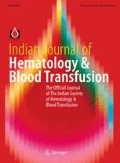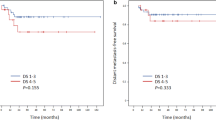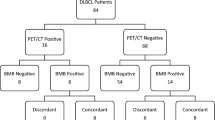Abstract
We retrospectively analyzed the prognosis of patients with diffuse large B cell lymphoma (DLBCL) and a bulky mass at diagnosis. We retrospectively analyzed clinical data for 29 consecutive DLBCL patients with an initial bulky mass receiving R-CHOP (rituximab, cyclophosphamide, doxorubicin, vincristine, and prednisolone) therapy from 2004 to 2011. Bulky disease was defined as a measurable tumor mass >10 cm in diameter or a mediastinal mass >1/3 of the chest diameter. Patients with primary mediastinal large B-cell lymphoma were excluded. The median age was 65 years (20–78 years) and the maximum tumor diameter was 11.5 cm (10.0–17.0 cm). Complete response and partial response were achieved in 14 patients each, while 1 patient had progressive disease. The 3-year overall survival (OS) rate and progression-free survival (PFS) rate were 66 and 56 %, respectively. Findings on post-treatment positron emission tomography-computed tomography (PET–CT) were significantly associated with OS (34 % for patients with abnormal uptake vs. 75 % for those without, P = 0.014), and were also associated with PFS (36 vs. 83 %, respectively, P < 0.001). Nine patients with a single site of abnormal uptake on PET–CT underwent radiotherapy and 5 of them subsequently relapsed. An initial bulky mass does not indicate a poor prognosis of DLBCL. However, the post-treatment PET–CT findings may have predictive value in DLBCL patients with a bulky mass.



Similar content being viewed by others
References
Shipp MA, Harrington DP, Klatt MM et al (1986) Identification of major prognostic subgroups of patients with large-cell lymphoma treated with m-BACOD or M-BACOD. Ann Intern Med 104:757–765
Hurvich CM, Simonoff JS, Tsai C-L (1998) Smoothing parameter selection in nonparametric regression using an improved Akaike information criterion. J R Stat Soc 60:271–293
Fisher RI, DeVita VT Jr, Johnson BL et al (1977) Prognostic factors for advanced diffuse histiocytic lymphoma following treatment with combination chemotherapy. Am J Med 63:177–182
Danieu L, Wong G, Koziner B et al (1986) Predictive model for prognosis in advanced diffuse histiocytic lymphoma. Cancer Res 46:5372–5379
Hoskins PJ, Ng V, Spinelli JJ et al (1991) Prognostic variables in patients with diffuse large-cell lymphoma treated with MACOP-B. J Clin Oncol 9:220–226
Savage KJ, Al Rajhi N, Voss N et al (2006) Favorable outcome of primary mediastinal large B-cell lymphoma in a single institution: the British Columbia experience. Ann Oncol 17:123–130
Tomita N, Kodama F, Motomura S et al (2008) Adjuvant radiotherapy to an initial bulky mass in diffuse large B-cell lymphoma: lack of survival benefit. Int J Lab Hematol 30:53–57
Habermann TM, Weller EA, Morrison VA et al (2006) Rituximab-CHOP versus CHOP alone or with maintenance rituximab in older patients with diffuse large B-cell lymphoma. J Clin Oncol 24:3121–3127
Coiffier B, Lepage E, Briere J et al (2002) CHOP chemotherapy plus rituximab compared with CHOP alone in elderly patients with diffuse large-B-cell lymphoma. New Engl J Med 346:235–242
Pfreundschuh M, Ho AD, Cavallin-Stahl E, Wolf M, Pettengell R, Vasova I, Belch A, Walewski J, Zinzani PL, Mingrone W et al (2008) Prognostic significance of maximum tumour (bulk) diameter in young patients with good-prognosis diffuse large-B-cell lymphoma treated with CHOP-like chemotherapy with or without rituximab: an exploratory analysis of the MabThera International Trial Group (MInT) study. Lancet Oncol 9:435–444
Lister TA, Crowther D, Sutcliffe SB et al (1989) Report of a committee convened to discuss the evaluation and staging of patients with Hodgkin’s disease: cotswolds meeting. J Clin Oncol 7:1630–1636
Takemura S, Tomita N, Koharazawa H et al (2012) Phase II study of CHOP-GR therapy in diffuse large B-cell lymphoma. Int J Hematol 96:241–246
Cheson BD, Pfistner B, Juweid ME et al (2007) International harmonization project on lymphoma. Revised response criteria for malignant lymphoma. J Clin Oncol 25:579–586
Song MK, Chung JS, Sung-Yong O et al (2010) Clinical impact of bulky mass in the patient with primary extranodal diffuse large B cell lymphoma treated with R-CHOP therapy. Ann Hematol 10:985–991
Fukuhara S, Watanabe T, Munakata W et al (2011) Bulky disease has an impact on outcomes in primary diffuse large B-cell lymphoma of the breast: a retrospective analysis at a single institution. Eur J Hematol 5:434–440
Juweid ME, Wiseman GA, Vose JM et al (2005) Response assessment of aggressive non-Hodgkin’s lymphoma by integrated international workshop criteria and fluorine-18-fluorodeoxyglucose positron emission tomography. J Clin Oncol 23:4652–4661
Meignan M, Barrington S, Itti E et al (2014) Report on the 4th international workshop on positron emission tomography in lymphoma held in Menton, France, 3–5 October 2012. Leuk Lymphoma 55:31–37
Conflict of interest
The authors have no conflict of interest to declare.
Author information
Authors and Affiliations
Corresponding author
Rights and permissions
About this article
Cite this article
Takasaki, H., Yamamoto, W., Ishii, Y. et al. Post-treatment PET–CT Findings may Predict the Prognosis of DLBCL with a Bulky Mass. Indian J Hematol Blood Transfus 31, 346–351 (2015). https://doi.org/10.1007/s12288-014-0479-9
Received:
Accepted:
Published:
Issue Date:
DOI: https://doi.org/10.1007/s12288-014-0479-9




